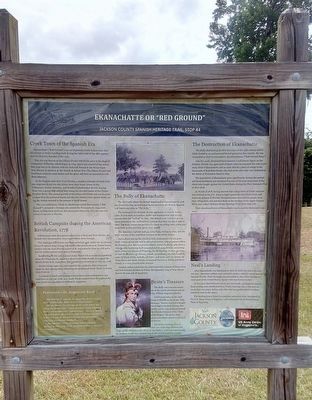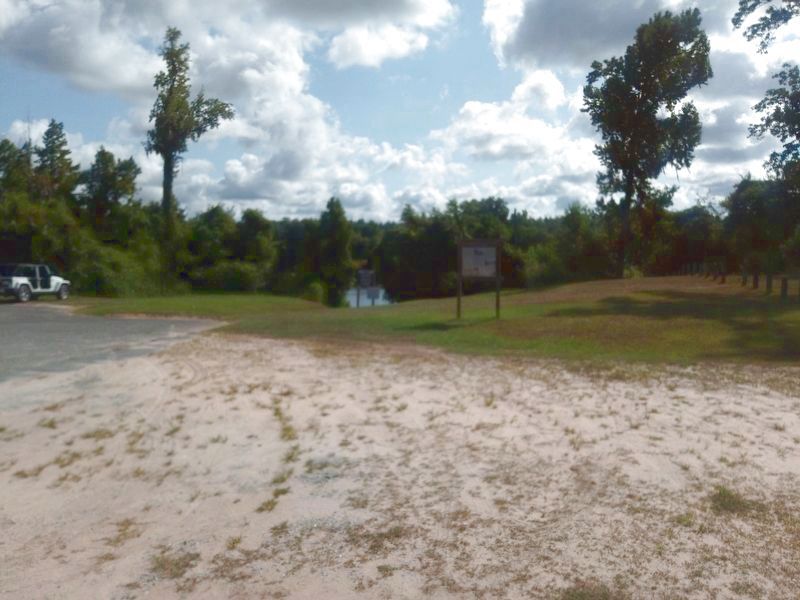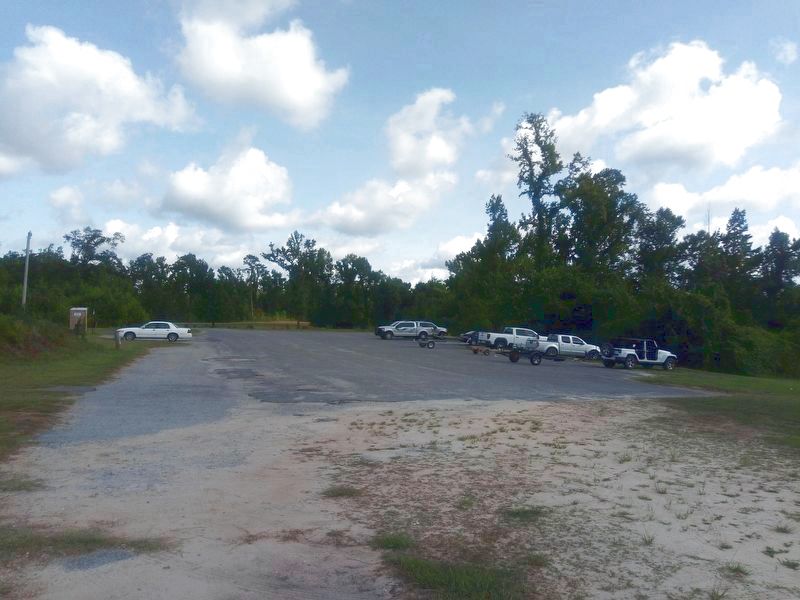Near Bascom in Jackson County, Florida — The American South (South Atlantic)
Ekanachatte or "Red Ground"
Jackson County Spanish Heritage Trail, Stop #4
Creek Town of the Spanish Era
Ekanachatte ("Red Ground") was an important Creek Indian town that stood here at Neal's Landing Park during the latter half of the 18th century and the first two decades of the 19th.
This site was known as the Chisca (Yuchi) Old Fields prior to the English Occupation of Florida, which began in 1763. Spain lost control of the colony that year due to its alliance with the defeated French in the Seven Years War, known in America as the French & Indian War. The Chisca (Yuchi) had lived here some 90 years before and the place still bore an association with their memory.
As the English arrived in West Florida, a number of bands of Creek Indians migrated down into the colony from their hometowns on the Tallapoosa, Coosa, Alabama, and Middle Chattahoochee Rivers. Among these was a group that settled here along the elevated banks of the Chattahoochee River. The second growth of the Chisca Old Fields was much easier to clear than the primeval forest and the new settlers soon opened fields, using the timber secured in the process to build homes.
The new settlement, which its inhabitants called Ekanachatte ("Red Ground), occupied a strategic site astride the Pensacola-St.Augustine Road, an important pathway that connected what were then the only two towns of any size in Florida.
British Campsite during the American Revolution, 1778
Fifteen years after they gained possession of East and West Florida, the British were threatened by American Patriots from Georgia.
The American Revolution was then underway and, unlike the 13 colonies in revolt against King George III the Floridas remained loyal. Patriot forces tried to take the East Florida capital of St Augustine by force in 1778 and a call for reinforcement went west to Pensacola.
Responding to this call, Colonel James Stuart led an overland expedition along the Pensacola-St Augustine Road from West Florida to support the British forces at St. Augustine. The expedition arrived here on July 25, 1778.
Stuart and his men were welcomed by the residents of the town and spent six days among them, observing the traditional Creek "Busk" or Green Corn Festival.
A council of chiefs and leading warriors from surrounding towns was held here on July 28, 1778. As a result, Creek warriors from throughout the ares joined the expedition to defend St. Augustine.
The Bully of Ekanachatte
The chief with whom the British negotiated at Ekanachatte in 1778 was named Cockee, an individual better known to the British, Spanish and Americans alike as "The Bully."
The name grew not because he was aggressive or violent, but because he was such an excellent trader and businessman that his customers often felt "bullied" by him. The British were forced to give so many presents to the chief and his warriors that they ran out of gifts to offer. The Bully solved this problem for them by selling some of the presents back so they could be given away again!
The American explorer and spy John Pope, writing in 1792, said the Bully was one of the wealthiest two men in the Creek Nation:
Agriculture among the Creeks is little understood and less practiced. I know of but one man in the whole nation, who possesses tolerable industry, and that is a private citizen, called the Bully, who from a very humble beginning hath accumulated an easy fortune, consisting of the following Species of Property, viz. Of Negroes, 16 men, 19 women and 26 children. Of Horses, 5 studs, 32 geldings, 127 mares and 83 colts. Of black Cattle, 19 bulls, 58 steers, 326 cows, and 132 calves. Of Hogs about 300 head; besides Household Furniture, Peltry and Store Goods, to a very considerable amount.
Another writer noted that the chief lived with a harem of three wives and had as many children as Priam, the legendary king of Troy who fathered 68 sons and 18 daughters.
Pirate's Treasure
The Bully was a known associate of the noted adventurer and pi rate, William Augustus Bowles.
Celebrated
today on the Gulf Coast of Florida as the pirate "Billy Bowlegs," Bowles married a daughter of the Creek chief Thomas Perryman and in 1795 declared himself the Director General of the "State of Muskogee." His pirate ships preyed merchant vessels in the Gulf of Mexico.
His letters mention plans to send one of his ships loaded with cargo up the Chattahoochee River to "the Bully's" and local legend holds the treasure is still here, buried deep in the mud of a nearby swamp.
The Destruction Ekanachatte
The Bully died during the first few years of the 19th century and is likely buried in an undiscovered burial ground in this vicinity. He was succeeded as chief by his nephew, Econchanttimico ("Red Ground King").
Like his uncle, Econchattimico became a well known figure on the frontier. Florida was again part of Spain when he assumed the role of primary chief of Ekanachatte and as such offered a place of refuge to the thousands of Red Stick Creeks who fled south after they were defeated at the Battle of Horseshoe Bend in 1814.
The population of Ekanachatte grew significantly during this period and Econchattimico was recognized as one of the most important of the chiefs who fought against the United States during the First Seminole War of 1817-1818.
In March of 1818, having learned that a large force of Creek warriors had enlisted in the U.S. Army to fight against the Red Stick Creek and Seminole alliance in Florida, Econchattimico removed his people from their village here and secreted them in the swamps of the upper Chipola River near today's Bellamy Bridge Heritage Trail (Tour Stop #8).
Their abandoned town of Ekanachatte was burned by Melintosh's warriors.
Neal's Landing
After Ekanachatte was destroyed in 1818, its fields lay fallow for only one year. American settlers soon arrived to stake a claims to prime land in Spanish Florida. Their foresight was rewarded in 1821 when Florida became part of the United States. Spain's rule was forever ended.
In the years that followed a ferry and eventually a prosperous steam boat landing were established here, Neal's Landing was a vital port for more than 100 years, fading only when the last paddlewheel riverboat ended its runs in the 1940s.
The landing is now home to a popular recreation area, developed by the U.S. Army Corps of Engineers and maintained by Jackson County Parks & Recycling.
(sidebar)
Pensacola-St. Augustine Road
The historic Pensacola St. Augustine Road crossed the Chattahoochee River here at Ekanachatte.
No one knows the real age of the road, which ran along the approximate route of today's State Highway 2. First used by American Indian hunters, the trail was in use well before the end of Florida's first Spanish era in 1763. It is one of the oldest known transportation routes in the Florida Panhandle.
You can learn more about the historic road in Malone at Tour Stop #5 on the Jackson County Spanish Heritage Trail.
Erected by Jackson County Jackson, US Army Corps of Engineers. (Marker Number 4.)
Topics. This historical marker is listed in these topic lists: Colonial Era • Native Americans • Parks & Recreational Areas • Roads & Vehicles • Settlements & Settlers • War, French and Indian • War, US Revolutionary • Wars, US Indian • Waterways & Vessels. A significant historical year for this entry is 1763.
Location. 30° 58.407′ N, 85° 0.377′ W. Marker is near Bascom, Florida, in Jackson County. Marker can be reached from Florida Route 2, one mile east of Timberlake Road, on the right when traveling east. Located at Neil's Landing on Florida-Georgia state line. Touch for map. Marker is at or near this postal address: 7001 FL-2, Bascom FL 32423, United States of America. Touch for directions.
Other nearby markers. At least 8 other markers are within 9 miles of this marker, measured as the crow flies. Lovedale Baptist Cemetery (approx. 6.9 miles away); Wallace Zachariah Nolyar Bowers (approx. 6.9 miles away); Bascom School (approx. 7˝ miles away); Seminole County World War II Memorial (approx. 8.6 miles away in Georgia); Korean Conflict "The Forgotten War" (approx. 8.6 miles away in Georgia); Seminole County Vietnam War Memorial (approx. 8.6 miles away in Georgia); Seminole County (approx. 8.6 miles away in Georgia); City of Donalsonville (approx. 8.8 miles away in Georgia). Touch for a list and map of all markers in Bascom.
Also see . . . Jackson County Spanish Heritage Trail. Website homepage (Submitted on July 8, 2022.)
Credits. This page was last revised on July 11, 2022. It was originally submitted on July 3, 2022, by James L.Whitman of Eufaula, Alabama. This page has been viewed 403 times since then and 103 times this year. Photos: 1. submitted on July 3, 2022, by James L.Whitman of Eufaula, Alabama. 2, 3. submitted on July 10, 2022, by James L.Whitman of Eufaula, Alabama. • Bernard Fisher was the editor who published this page.


